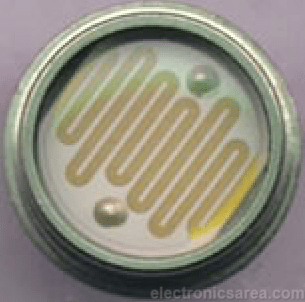What is an LDR?
LDR (Light Dependent Resistor) is a light sensitive resistor whose resistance changes with the light intensity that falls upon it. Photoresistor (photo resistor) is manufactured with crystalline structure materials using its photo conductive properties. The most common crystal used are: cadmium sulphide and cadmium selenite.
Normal values for a LDR goes from 50 ohms to 1K (1000 ohms) when it is fully illuminated, and from 50K (50 000 ohms) to several Megohms when it is in the dark.
Photoresistor advantages
- They are available in different sizes and shapes.
- Need a small voltage for its operation.
- They are bidirectional and cheap.
- Its resistance does not change instantly when it goes from darkness to light or from light to darkness, and the time LDR takes on these two processes is not always the same.
Photoresistor disadvantages
- As photoresistors does not change its value instantly, they can not be used in many applications, especially those that need a lot of accuracy in time (the time it takes to change its state from dark to light or from light to darkness).
- Another disadvantage is the different values a photoresistor may have for a specific light intensity that falls upon it. Its typical response time is approximately 0.1 seconds.
LDR applications
There are many applications in which a photoresistor is very useful. There are cases where the accuracy of the changes is not important, and neither the exact value of its resistance.
For example
- In automatic streetlights. A very simple circuit using LDR automatically switches ON lights in the evening after sunset. The same circuit automatically switches OFF lights when Sunlight fall on LDR in morning.
- Alarm systems
- Automatic emergency light system
- Automatic Luminous neon signs
- A lot of circuits and projects
Photoresistor symbol are:

More resistor tutorials
- Resistors in Series – The Equivalent Resistance
- Resistors in parallel (Equivalent resistor value)
- Resistors in parallel (Equivalent resistor value)
- Series/Parallel Resistor Reduction
- What is Electrical Resistivity?
- Resistor Tolerance. What is it? – Color code
- Temperature effect on resistance
- What is Electrical Resistance? Obtaining a material’s resistance
- Wirewound Resistor
- LDR – Photoresistor





